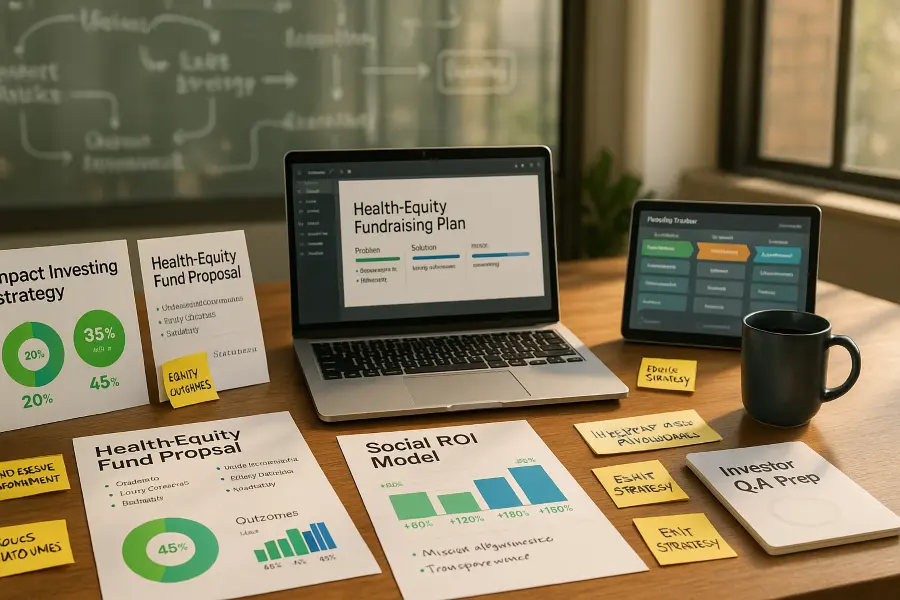Healthcare innovation holds unprecedented potential to transform lives, yet funding remains a critical barrier for ventures addressing society's most pressing health challenges. Impact investing bridges this gap by uniting financial returns with measurable social outcomes, enabling startups to tackle accessibility, equity, and care delivery while attracting capital from mission-aligned investors.
The momentum is undeniable. The impact investing sector reached $1.57 trillion in assets under management in 2024, growing at a 21% CAGR since 2019. This expansion reflects deepening conviction that capital can generate competitive returns while driving meaningful societal progress.
This guide explores the frameworks shaping impact investments, examines health-equity funds designed to close care gaps, and provides actionable strategies for both investors seeking purpose-driven portfolios and founders building ventures that improve health outcomes at scale.
Let's dive into the transformative potential of impact investing in healthcare.
What Is Impact Investing in Healthcare?
Impact investing is an investment approach that intentionally seeks to generate positive, measurable social or environmental outcomes in addition to financial returns. Unlike traditional investing, which is profit-centric, or philanthropy, which expects no financial return, impact investing occupies the middle ground, targeting both impact and profit.

- Set clear impact goals
- Research available investment vehicles
- Assess relevant measurement metrics
- Partner with knowledgeable organizations
For example, a telemedicine company expanded access for rural patients, attracting both financial and impact investment. For entrepreneurs seeking capital without sacrificing ownership, your exploration of funding strategies includes non-dilutive funding healthcare startups, which examines options to secure capital while keeping your equity intact.
Why Healthcare Is a Prime Target
Healthcare is one of the most active and impactful sectors for impact investing in healthcare. This field addresses urgent global challenges such as access to care, disease prevention, affordable medicines, and health equity.
Investor confidence in healthcare remains strong. In a 2025 study, 89% of Asia-focused impact investors managing over USD 38 billion found financial returns met or exceeded expectations. This emphasizes both societal impact and robust financial results in healthcare investment.
Impact investors in healthcare back companies and funds that:
- Expand access to essential health services in underserved communities
- Develop affordable medical technologies and medicines
- Promote preventive care and public health
- Support digital health, telemedicine, and mobile health initiatives
- Address social determinants of health such as housing and nutrition. These non-medical factors influence health outcomes.
Impact Investing Framework in Healthcare
Impact investing in healthcare is reshaping how capital addresses social inequalities while generating measurable returns. With the global healthcare sector valued at $8.3 trillion, representing 10% of global GDP—the opportunities for investments that deliver both financial performance and improved health outcomes are substantial.
Since 2020, impact investing has grown at 29% annually, reflecting increasing alignment between profit motives and social impact objectives.
Establishing Industry Standards
Collaborative efforts are creating credible frameworks for measuring and reporting impact. In November 2025, the Impact through Collaboration event convened over 150 policymakers, investors, and healthcare leaders to launch new standards for healthcare impact investing.
These frameworks help investors align capital deployment with positive health outcomes while maintaining accountability through metrics tied to the UN Sustainable Development Goals (SDGs), enabling investments to deliver both financial and social dividends.
State-sponsored initiatives like government healthtech grants demonstrate how public support can complement private investments. By aligning with these programs, impact investors can broaden reach while addressing systemic healthcare challenges that purely commercial capital might overlook.
Digital Health and Biotech AI: High-Growth Impact Areas
Digital health continues attracting substantial capital. In 2024, U.S. digital health startups secured $10.1 billion in venture funding across 497 deals, with total U.S. digital health funding reaching $17.2 billion, a 4% year-over-year increase. Notably, 85% of venture funding concentrated on six high-impact value propositions: telemedicine platforms, mental health solutions, chronic disease management, remote patient monitoring, care coordination tools, and personalized medicine technologies.
Biotech AI represents another explosive growth area, with investments reaching $5.6 billion in 2024, nearly tripling from previous years. This surge reflects AI's transformative potential to accelerate drug discovery, personalize treatments, and optimize healthcare delivery. These technologies promise not just financial returns but fundamental improvements in patient outcomes and treatment accessibility.
Geographic Concentration and Implications
Regional differences remain pronounced. The U.S. contributed 70% of global digital health venture funding in 2024, creating concentration that affects where frameworks and investment tools gain early traction.
This geographic imbalance presents both challenges, underinvestment in emerging markets with acute health needs, and opportunities for impact investors willing to deploy capital in underserved regions where health outcomes improvements can be most dramatic.
Additionally, state-sponsored initiatives like government grants healthtech demonstrate how public support can complement private investments. By aligning with these programs, investors can broaden their impact while addressing systemic healthcare challenges.
Types of Impact Investments in Healthcare
Measuring Impact
A defining feature of impact investing in healthcare is the requirement for measurable outcomes. Investors use frameworks such as ESG ratings and SDG alignment.
Comparing Leading Impact Measurement Frameworks
| Framework | Focus Area | Best Use Case |
|---|---|---|
| IRIS+ | Standardized metrics for social and financial outcomes | Portfolio-wide reporting and benchmarking |
| SDG Alignment | Global development goals and thematic impact | Strategic alignment with international priorities |
| ESG Ratings | Environmental, social, and governance practices | Screening and monitoring public companies |
A detailed review of such programs can be found in healthtech accelerator seed funding, which highlights how these initiatives contribute to early-stage financing.
The Role of Standardized Impact Measurement and Validation
Building on robust investment structures, healthcare impact investors increasingly rely on standardized frameworks such as IRIS+ to measure outcomes. These tools enable consistent tracking of both social and financial performance across diverse portfolios. Independent validation by third parties further enhances transparency, ensuring reported results are credible and comparable. This approach builds trust among stakeholders and supports continuous improvement in investment strategies.
Structuring Investments for Maximum Impact
Aligning investments with global benchmarks like the UN Sustainable Development Goals provides accountability and focus. SDG 3 emphasizes reducing maternal mortality, combating epidemics, and achieving universal health coverage, objectives that guide impact-focused healthcare portfolios.
Recent data informs structure selection: by mid-2025, HealthTech 250 companies raised $647 million across 33 deals, averaging $22.5 million per round. However, digital health funding declined 13% in H1 2025 versus H1 2024, reflecting shifting investor sentiment.
Effective impact investment structures anticipate market fluctuations while maintaining commitment to measurable health outcomes, balancing financial discipline with mission-driven objectives that deliver sustainable returns alongside improved care access and quality.
For those looking to explore funding strategies, this comprehensive guide to healthcare startup funding offers valuable insights into securing capital while aligning with impact goals.
Benefits for Healthcare Startups and Investors
- Startups gain access to mission-aligned capital, often at early stages when traditional funding is scarce.
- Investors achieve portfolio diversification, competitive returns, and measurable societal benefit.
- Communities benefit from improved health outcomes, access, and innovation.
Getting Started with Impact Investing in Healthcare
- Define Your Impact Goals: Identify the health challenges or populations you want to support.
- Select Investment Vehicles: Choose from direct equity, funds, bonds, or microfinance based on risk/return and impact appetite.
- Assess Impact Metrics: Use recognized frameworks to measure and report on health and social outcomes.
- Engage with Partners: Collaborate with NGOs, governments, and other impact investors for greater reach and expertise.
Scaling Impact Through Multi-Sector Partnerships
This collaboration strategy enables investors and startups to pool capital, share knowledge, and access broader networks. Multi-sector partnerships often include public agencies, nonprofits, and private investors working toward shared health outcomes. Co-investment reduces risk for each participant while increasing the scale and sustainability of interventions. Such alliances can accelerate innovation and expand access to underserved populations.
Conclusion
Healthcare impact investing thrives on the integration of strategic frameworks, data-driven insights, and real-world case studies. Throughout this blog, we explored key approaches to impact investing, highlighted critical statistics, and shared expert perspectives that underscore the importance of aligning financial goals with measurable social outcomes.
Healthcare impact investing thrives on strategic frameworks and data-driven insights. Impact investing in healthcare aligns financial goals with measurable social outcomes. By adopting data-centric strategies and learning from proven examples, investors can make informed decisions that drive meaningful change in healthcare.
If you are building a healthcare venture and want to raise from mission aligned investors, Qubit Capital’s healthcare fundraising assistance can help. We work with you to clarify your impact thesis, shape a data backed story, and target the right impact and healthcare investors so your round is built on more than hope and a pitch deck.
Key Takeaways
- Impact investing in healthcare targets both financial returns and measurable social outcomes, not charity on one side or pure profit on the other.
- Digital health and biotech AI attract a growing share of impact capital, because they scale fast and directly improve patient outcomes.
- Clear impact frameworks, like SDG and IRIS aligned metrics, are now mandatory to win serious impact investors and maintain credibility.
- Healthcare startups that bake in regulation, access, and equity from day one are better positioned to raise aligned, long term capital.
Frequently asked Questions
What is impact investing in healthcare?
Impact investing in healthcare means allocating funds to projects that seek both financial returns and measurable social good.






